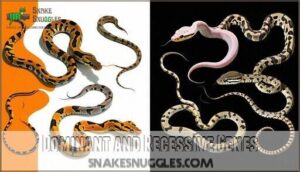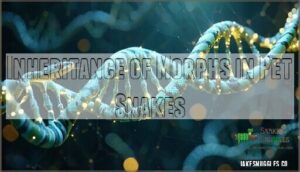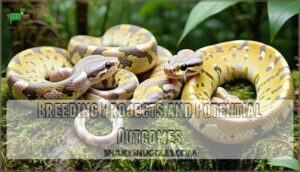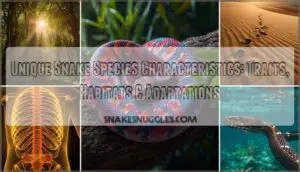This site is supported by our readers. We may earn a commission, at no cost to you, if you purchase through links.
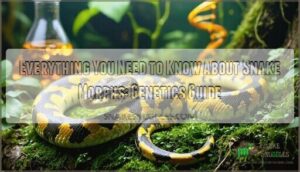
You’ll encounter dominant genes that show up with just one copy and recessive traits requiring two copies to express visually. Understanding allelic interactions helps you predict breeding outcomes using Punnett squares, turning each pairing into a calculated gamble rather than pure luck.
Whether you’re working with amelanistic corn snakes or complex ball python combinations, successful morph production creates both personal satisfaction and serious market value. The genetics behind these living masterpieces reveal intricate patterns of inheritance that smart breeders leverage for profitable projects.
Table Of Contents
- Key Takeaways
- Genetic Variations in Snake Appearance
- Dominant and Recessive Genes
- Inheritance of Morphs in Pet Snakes
- Breeding Projects and Potential Outcomes
- The Role of a Punnett Square in Understanding Breeding Possibilities
- Frequently Asked Questions (FAQs)
- Why do snakes have morphs?
- Does a snake have color morphs?
- What types of snakes are used to make Morphs?
- What is a snake morph?
- Are King Snake morphs genetic?
- How do snakes create new morphs?
- What is the difference between a morph and a mutation in snakes?
- How do snake morphs affect the snake’s quality of life?
- What are the most common genetic issues associated with snake morphs?
- How much do snake morphs cost?
- Conclusion
Key Takeaways
- You’ll need to understand that snake morphs result from genetic mutations affecting chromatophores, with dominant genes requiring only one copy to express while recessive genes need two copies from both parents.
- You can predict breeding outcomes using Punnett squares to calculate genetic probabilities, turning morph production from guesswork into strategic planning with measurable success rates.
- You’ll find that popular species like ball pythons, corn snakes, and kingsnakes offer the most stable genetics and market demand, with prices ranging from $40 for basics to $10,000+ for rare combinations.
- You must avoid problematic genetic lines like Spider morphs with wobble syndrome or Desert morphs with kinking issues, as these can cause serious health problems that affect your snake’s quality of life.
Genetic Variations in Snake Appearance
You’ll discover that snake coloration stems from chromatophores—specialized pigment cells in their skin. These genetic variations create stunning visual differences through specific mutations.
The CLCN2 gene controls whether corn snakes display fused dorsal spots or distinctive stripe patterns. Albinism genetics eliminate melanin production, creating those striking white and yellow morphs you see at reptile shows. Color mutations like hypomelanism reduce pigment intensity, while axanthism removes yellow tones entirely.
Scale patterns emerge from complex phenotypic expression involving multiple genes. Selective breeding amplifies these naturally occurring genetic variations, turning random mutations into profitable morph combinations that command premium prices in today’s market. Understanding allele inheritance is essential for predicting traits.
Dominant and Recessive Genes
Understanding snake genetics starts with dominant and recessive genes. When you’re breeding snakes, homozygous traits express fully while heterozygous alleles create different outcomes. Dominant genes show up with just one copy, but recessive genes need two copies to appear. This affects genetic probability and phenotype influence in your breeding projects.
Here’s what makes genetic inheritance exciting:
- You’ll witness stunning color combinations emerge from careful genetic planning
- Each breeding season brings anticipation as genetic mutations reveal themselves
- Successfully producing rare morphs creates outstanding satisfaction and market value
- Understanding gene expression helps you predict offspring characteristics with confidence
- Watching recessive traits finally appear after generations feels like discovering treasure
Genetic probability calculations help predict breeding outcomes, making each pairing a calculated gamble with beautiful rewards.
Inheritance of Morphs in Pet Snakes
Snake genetics work like a complex recipe where you’re mixing ingredients from both parents. Color and pattern morph genes occur in pairs, with offspring inheriting one allele from each parent through sexual reproduction. These inheritance patterns determine what visual traits, or phenotypes, your snake displays.
Heterozygous snakes carrying one morph allele and one normal allele might look ordinary but can surprise you by passing hidden traits to their babies. Environmental gene influence and polygenic morph traits mean multiple genes work together, creating those stunning morphs we chase.
Understanding how a single gene affects patterns helps clarify the genetic basis of these variations. Predicting offspring morphs becomes easier when you understand these allelic interactions and gene expression control mechanisms working behind the scenes.
Breeding Projects and Potential Outcomes
Once you understand inheritance patterns, you’re ready to tackle breeding projects. These ventures combine specific designer morphs to create unique offspring with targeted traits. Your project goals might include producing blue-eyed leucistics or stacking multiple genes for rare combinations. Success rates vary dramatically—het-to-het pairings yield 25% visual offspring, while proven dominant pairings can produce 50% or higher rates. Genetic testing is essential to avoid defect-prone combinations, ensuring healthier offspring.
Here are four breeding realities that’ll hit you:
- Your dream morph combo might take 3-5 seasons to achieve
- Unexpected results can crash your projected market values overnight
- Genetic mutations don’t always cooperate with your timeline
- Ethical concerns arise when chasing extreme morphs with health issues
Snake breeding demands patience and realistic expectations about breeding possibilities.
The Role of a Punnett Square in Understanding Breeding Possibilities
Planning your next breeding project involves more than just pairing your favorite snakes. Punnett squares serve as your roadmap for predicting breeding outcomes and understanding genetic probability. These simple grids help you visualize how parent genotypes combine to produce offspring phenotype ratios.
When you’re working with morph inheritance, the Punnett square shows exactly what you can expect. If you’re breeding a heterozygous pastel ball python to a normal, you’ll get 50% pastels and 50% normals – no surprises. This genotype prediction tool becomes invaluable when planning multi-gene projects or calculating the odds of hitting that expensive recessive combo. Understanding how codominant genes blend traits can further improve these predictions.
Snake breeding success often comes down to understanding these genetic inheritance patterns. You can’t just throw two pretty snakes together and hope for the best. The Punnett square helps you set realistic expectations and price your breeding possibilities accordingly. It’s basic genetics, but it’ll save you from costly mistakes.
Frequently Asked Questions (FAQs)
Why do snakes have morphs?
It’s not rocket science—you’ll find morphs exist because recessive genes from both parents combine, creating unique phenotypes.
Selective breeding amplifies these natural mutations, turning genetic lottery tickets into valuable breeding stock that collectors can’t resist buying.
Does a snake have color morphs?
Yes, you’ll find snakes display remarkable color morphs through genetic mutations. These recessive alleles create stunning albinos, piebalds, and other variations that breeders actively pursue for their unique appeal.
What types of snakes are used to make Morphs?
You’ll find ball pythons, corn snakes, and kingsnakes are the top choices for morph breeding.
These species offer stable genetics, proven breeding lines, and strong market demand for their colorful variations.
What is a snake morph?
A snake morph is a genetic variation that creates unique colors or patterns through inherited mutations. These variations result from recessive genes, selective breeding, or natural genetic combinations that produce striking visual differences from wild-type snakes.
Are King Snake morphs genetic?
Like DNA fingerprints, king snake morphs are absolutely genetic treasures you’ll inherit through selective breeding. These recessive and codominant alleles create stunning pattern variations when you pair the right genetics together.
How do snakes create new morphs?
Breeders create new morphs by selectively pairing snakes carrying recessive genes, producing offspring with unique color patterns through careful genetic planning and generational breeding programs.
What is the difference between a morph and a mutation in snakes?
You’re dealing with two distinct concepts here. A mutation is the actual genetic change in DNA that creates something new, while a morph is the visible result you see in the snake’s appearance when that mutation gets expressed through breeding.
How do snake morphs affect the snake’s quality of life?
Most morphs don’t impact quality of life, but you’ll want to avoid problematic lines like Spider balls with wobble syndrome or Desert morphs with kinking issues that can cause real suffering.
What are the most common genetic issues associated with snake morphs?
You’ll encounter wobble syndrome in Spider morphs, kinking issues in Caramel Albinos, and fertility problems in Desert lines.
These neurological and structural defects often come from recessive genes being doubled up.
How much do snake morphs cost?
You’ll pay anywhere from $40 for basic morphs like normals to $10,000+ for rare genetics. Common pastels and mojaves run $150-300, while designer combos reach $1,000-5,000 depending on their market demand.
Conclusion
Picture Sarah’s excitement when her first leucistic ball python project finally hatched—three years of careful planning paid off with stunning white scales and blue eyes worth $2,000 each.
Mastering everything you need to know about snake morphs transforms breeding from guesswork into strategic genetic planning. You’ll predict outcomes, calculate probabilities, and create valuable animals through understanding dominant, recessive, and co-dominant inheritance patterns.
Success requires patience, record-keeping, and knowledge of market demands, but the rewards—both financial and personal—make this genetic puzzle incredibly worthwhile for dedicated reptile enthusiasts.
- https://a-z-animals.com/blog/ball-python-morphs-discover-the-50-types/
- https://www.zenhabitats.com/blogs/reptile-care-sheets-resources/most-popular-ball-python-morphs-top-10-must-see
- https://www.youtube.com/watch?v=9-J21-f4upU
- https://support.morphmarket.com/article/298-understand-genetics
- https://www.reddit.com/r/ballpython/comments/neiqms/megathread_morphs_genetic_health_concerns/

